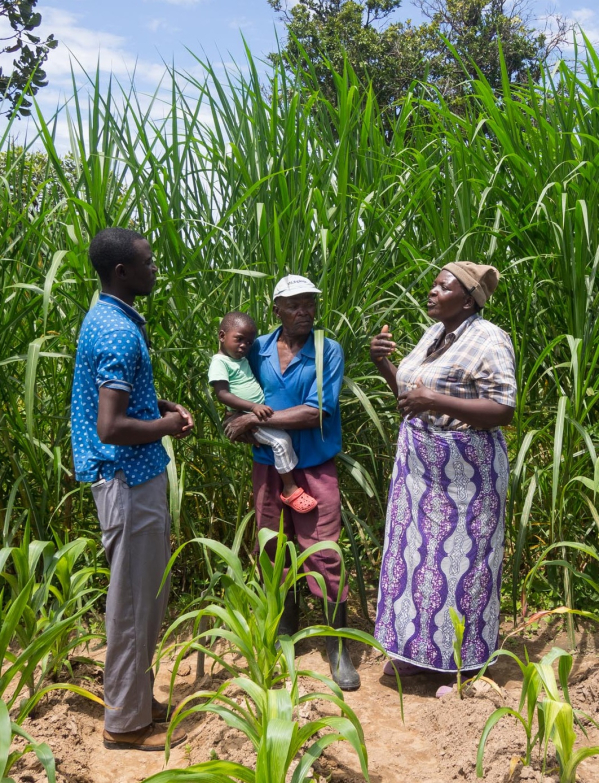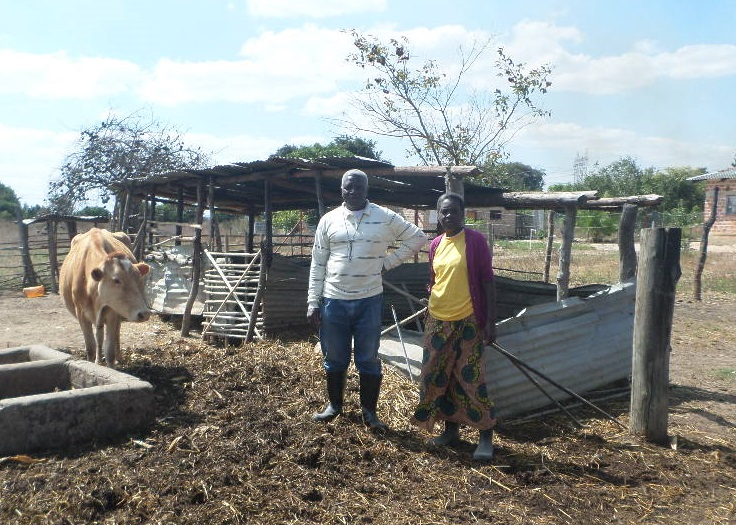News
Scientific evidence shows improving livestock productivity also reduces their environmental footprint

Agricultural development programmes, such as those funded by the New Zealand Government, recognise that small holder farmers in developing countries face significant barriers in maintaining secure livelihoods.
Right: Zambia Dairy Transformation Programme Extension Officer Chrispine Banda talks with Zambian dairy farmers Zachariah Thengo and Fridah Mukuka beside one of their fodder crops.
Ideally, agricultural development programmes increase on-farm productivity whilst also improving emissions efficiency and building resilience to the effects of climate change.
This so-called ‘triple win’ is a worthy pursuit; however, how does it actually occur at ground level?
To help answer this question, the Zambia Dairy Transformation Programme (ZDTP) was fortunate to be selected to participate in a study involving six New Zealand-funded agricultural aid projects that determined the greenhouse gas emission ‘footprint’ of cattle on dairy and beef farms (i.e. for example, the total emissions of CO2 per litre or kilogram of milk or meat produced).¹
The study carried out by AgResearch² also evaluated the effects of improved farm management practices on greenhouse gas (GHG) emissions.
“It is important that [New Zealand’s] agricultural aid projects consider more than just economic and cultural sustainability but also try to minimise effects on global GHG emissions and climate change.”
— Review of greenhouse gas profiles for six MFAT agricultural aid projects, AgResearch, November 2018
Information provided by the ZDTP came from a farm in Kwanshama owned by Mr and Mrs Kasamala, who have been working closely with the programme since its inception.
The couple have three dairy animals and, like many other farmers in the ZDTP's target areas (the programme is specifically targeting small holder farmers from six dairy cooperatives in two regions of Zambia: the Copperbelt and Central Province), they supply their milk to a milk collection centre.
Mrs Kasamala is Vice Chairperson on the board of her local dairy co-operative union and is one of the ZDTP’s ‘Focus Farmers’, which means, amongst other things, that she hosts demonstration plots on her farm to show other farmers how to grow new crops and conserve different types of fodder.
Above: Zambian dairy farmer Berringtone Musonda with a fodder crop for his animals.
AgResearch developed models calculating GHG emissions for two different management systems for the Kasamalas’ farm, using information such as the farm’s herd profile, feeding practices and waste management.
One was a ‘business as usual’ model, which was based on how the Kasamalas had been farming for the past five years. The other was an ‘improved’ model, which examined what would happen if they adopted the practices being promoted through the ZDTP, such as silage production, growing crops to produce home-made concentrates and supplementing feeds with nutritious locally sourced tree leaves.
The study found that the ‘improved’ farming system had potential to achieve both an increase in milk production and an overall reduction in the GHG footprint of the products produced on the Kasamalas’ farm.
In fact, AgResearch found that all six projects estimated a decrease in the GHG footprint of products (milk and/or meat) with the implementation of improved systems.
“Thus, while these projects have been focused on improving the sustainability and viability of the mainly smallholder livestock farm systems, they have resulted in increases in efficiency that have flowed through to a reduction in the GHG footprint of the livestock products produced (i.e. total GHG emissions per kilogram of product).”
— Review of greenhouse gas profiles for six MFAT agricultural aid projects, AgResearch, November 2018
According to the study, the main factors contributing to the reduction in the GHG footprint on the Kasamalas’ farm were:
♦ Increased milk production per cow (i.e. animals being more efficient in their production);
♦ Reduced amount of concentrates fed per cow (i.e. reduced GHG emissions associated with concentrate production, processing and transport);
♦ Use of locally grown maize silage (i.e. lower GHG emissions from on-farm production and use compared to that for bought-in concentrates); and
♦ Lower nitrogen (N) concentrations in the diet (i.e. less N excreted).
ZDTP Programme Country Manager Tania Thomson said it was pleasing to see evidence proving that the approaches being promoted by the ZDTP were able to benefit both farmers and the environment. “It really is a case of improved farm practices and productivity benefiting people, animals and the planet,” she said.
 |
Above: Mr and Mrs Kasamala on their farm.
Mrs Kasamala said she had learnt a lot from the ZDTP for the past two years in relation to cattle nutrition, animal and farm management. Through her involvement with the ZDTP, she had realised that growing fodder, coupled with silage making, would ensure that her animals had enough feed throughout the year. As a result, milk production would increase – as well as her income. The only hindrance was water for irrigation.
“I thought dairy farming was difficult and at some point, I wanted to quit, but now … I am managing and developing in terms of dairy farming,” Mrs Kasamala said. “Even when an animal is about to calve, I do not panic because [I know have already attended to my animals’] basic needs.”
¹ The projects were in Zambia (the ZDTP), Myanmar, Fiji, Colombia, Uruguay and Indonesia (four dairy and two beef cattle).
² AgResearch conducts research for the benefit of the agricultural sector in New Zealand and overseas (via international development programmes); for more information see www.agresearch.co.nz.




